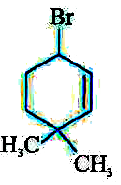Which on heating with aqueous KOH, produces acetaldehyde?
CH3−CH−Cl2
CH3−CO−Cl
CH3−CH2−Cl
CH2−Cl−CH2−Cl
The correct Answer is:A
To determine which compound, when heated with aqueous KOH, produces acetaldehyde, we can analyze the given options step by step.
Step 1: Identify the structure of acetaldehyde
Acetaldehyde has the molecular formula CH3CHO. It is a two-carbon aldehyde, where the functional group -CHO is attached to the second carbon.
Step 2: Analyze the options
We need to evaluate each option to see which one can yield acetaldehyde upon reaction with aqueous KOH.
Option D: CH2Cl2 (Dichloromethane)
- When CH2Cl2 is treated with aqueous KOH, the hydroxide ion (OH-) acts as a nucleophile and can replace one of the chlorine atoms. However, this will not lead to the formation of acetaldehyde. Instead, it may produce alcohols or other products.
Option C: CH3CH2Cl (Ethyl chloride)
- In this case, the OH- will replace the chlorine atom, leading to the formation of ethanol (CH3CH2OH). This does not yield acetaldehyde.
Option B: CH3COCH3 (Acetone)
- Here, the OH- will attack the carbonyl carbon, but it will not lead to the formation of an aldehyde. Instead, it may lead to other reactions that do not produce acetaldehyde.
Option A: CH3CCl2 (Dichloroethane)
- In this case, when CH3CCl2 is treated with aqueous KOH, the OH- can attack the carbon bonded to the chlorine atoms. The reaction will lead to the formation of acetaldehyde through the elimination of Cl- ions and rearrangement.
Conclusion
The compound that produces acetaldehyde when heated with aqueous KOH is CH3CCl2.
Acetaldehyde has the molecular formula CH3CHO. It is a two-carbon aldehyde, where the functional group -CHO is attached to the second carbon.
We need to evaluate each option to see which one can yield acetaldehyde upon reaction with aqueous KOH.
- When CH2Cl2 is treated with aqueous KOH, the hydroxide ion (OH-) acts as a nucleophile and can replace one of the chlorine atoms. However, this will not lead to the formation of acetaldehyde. Instead, it may produce alcohols or other products.
- In this case, the OH- will replace the chlorine atom, leading to the formation of ethanol (CH3CH2OH). This does not yield acetaldehyde.
- Here, the OH- will attack the carbonyl carbon, but it will not lead to the formation of an aldehyde. Instead, it may lead to other reactions that do not produce acetaldehyde.
- In this case, when CH3CCl2 is treated with aqueous KOH, the OH- can attack the carbon bonded to the chlorine atoms. The reaction will lead to the formation of acetaldehyde through the elimination of Cl- ions and rearrangement.
The compound that produces acetaldehyde when heated with aqueous KOH is CH3CCl2.
Topper's Solved these Questions
- BOOK - MODERN PUBLICATIONCHAPTER - ALDEHYDES ,KETONES AND CARBOXYLIC ACIDSEXERCISE - REVISION EXERCISES (OBJECTIVE QUESTIONS - PASSAGE BASED QUESTIONS )10videos
ALDEHYDES ,KETONES AND CARBOXYLIC ACIDS
- BOOK - MODERN PUBLICATIONCHAPTER - ALDEHYDES ,KETONES AND CARBOXYLIC ACIDSEXERCISE - REVISION EXERCISES (OBJECTIVE QUESTIONS - ASSERTION REASON QUESTIONS )10videos
ALDEHYDES ,KETONES AND CARBOXYLIC ACIDS
- BOOK - MODERN PUBLICATIONCHAPTER - ALDEHYDES ,KETONES AND CARBOXYLIC ACIDSEXERCISE - QUICK MEMORY TEST ( C. CHOOSE THE CORRECT ALTERNATIVE )19videos
ALDEHYDES ,KETONES AND CARBOXYLIC ACIDS
- BOOK - MODERN PUBLICATIONCHAPTER - ALCOHOLS, PHENOLS AND ETHERSEXERCISE - UNIT PRACTICE TEST (FOR BOARD EXAMINATION)12videos
ALCOHOLS, PHENOLS AND ETHERS
- BOOK - MODERN PUBLICATIONCHAPTER - BIOMOLECULESEXERCISE - UNIT PRACTICE TEST FOR BOARD EXAMINATION13videos
BIOMOLECULES
Similar Questions
Knowledge Check
- Question 1 - Select One
which of the following on heating with aqueous KOH produces acetaldehyde?
ACH3CH2ClBCH2ClCH2ClCCH3CHCl2DCH3COCl - Question 2 - Select One
which of the following on heating with aqueous KOH produces acetaldehyde?
ACH3)COClBCH3CH2ClCCH2ClCH2ClDCH3CHCl2 - Question 3 - Select One
Which of the following on heating with aqeous KOH produces acetaldehyde?
ACH3COClBCH3CH2ClCCH2ClCH2ClDCH3CHCl2.
 on treatment with aqueous KOHView Solution
on treatment with aqueous KOHView SolutionWhich of the following on heating with aq KOH produces butanaldehyde
View SolutionWhich of the following with aqueous KOH will give acetaldehyde ?
View Solution2, 3-Dimethylbut-2-ene when reacted with bromine forms a compound which upon heating with alcoholic KOH produce the following major product.
View SolutionA dihalogen derivative (A) with three C-atoms gives a hydrocarbon (B) on reacting with alc KOH. (B) gives a white precipitate with Tollen’s reagent. (A) on heating with aqueous KOH gives a ketone. Compound (A) is:
View Solution

